Referral Program Best Practices for Shopify Stores (with 10+ Examples and a Free Template)
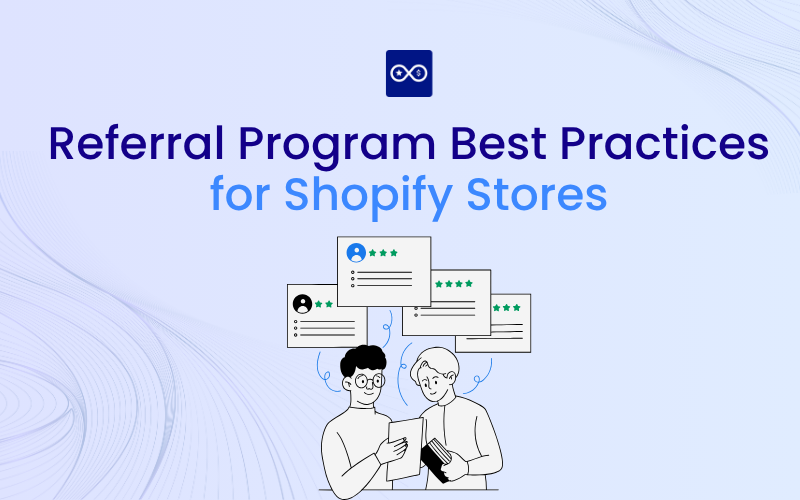
Customers nowadays trust real people far more than paid ads, which makes a well-designed referral program one of the most cost-effective and sustainable growth engines for Shopify stores. But simply launching a referral program isn’t enough. To truly succeed, merchants must follow referral program best practices, from choosing the right incentives and optimizing the user experience, to promoting the program at the perfect time and tracking its ROI. Done right, a referral program can turn satisfied shoppers into powerful brand advocates who drive repeat sales and new customer acquisition.
In this guide, we’ll walk you through all referral program best practices, especially focusing on eCommerce & Shopify as well, share 10+ real brand examples, and even include a free template to help you build your own referral campaign. Let’s explore!
What is a referral program and why it works?
Before diving into referral program best practices, it’s essential to understand the foundation: what a referral program actually is and why it consistently drives results for Shopify and eCommerce brands.
The Power of Word-of-Mouth in E-commerce
Consumers today are more skeptical of traditional ads, but they trust other shoppers. Word-of-mouth (WOM) remains one of the most powerful influences in purchasing decisions:
- 92% of consumers trust recommendations from friends and family over any form of advertising.
- Referred customers are 4x more likely to make a purchase and tend to have a higher lifetime value (CLV).
- Referrals build credibility because they come from authentic experiences, not sales messaging.
For Shopify stores, this means every happy customer is a potential micro-influencer. When your existing buyers promote your brand organically, you not only reduce marketing spend but also strengthen long-term trust – the core of eCommerce success.
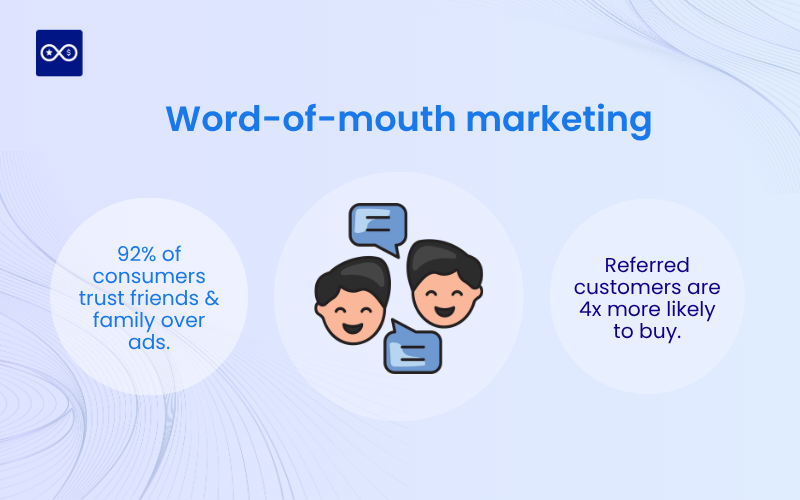
How Referral Programs Work?
A referral program is a structured system that rewards customers for spreading the word about your brand. It takes the natural act of recommending a product and turns it into a measurable, repeatable growth channel.
Here’s how it typically works:
- The advocate (referrer) shares a unique link or code with friends, family, or followers.
- The referred friend makes a purchase using that link or code.
- Both parties receive a reward, such as a discount, cashback, or free product.
This win-win model benefits everyone:
- Customers feel appreciated for their advocacy.
- New buyers get a positive first experience with an incentive.
- Brands acquire high-intent customers at a fraction of the cost of paid ads.
For Shopify merchants, referral programs can be easily managed through referral apps like Bloop referrals & Affiliate, ReferralCandy, or Gameball. These plugins help make setup, tracking, and reward distribution simple and automated.
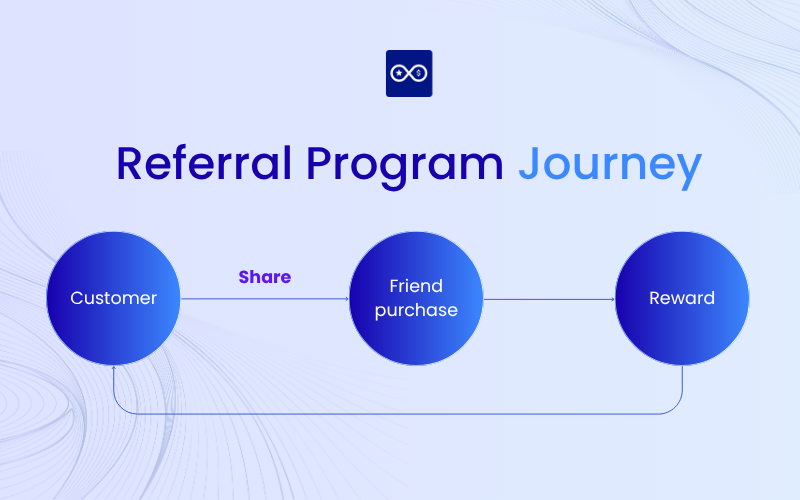
Why referral programs are perfect for Shopify stores?
Shopify stores are built for scalability and referral programs align perfectly with that. Here’s why:
- Low Customer Acquisition Cost (CAC): Instead of spending heavily on ads, merchants reward only for successful conversions.
- High Retention and Loyalty: Referred customers often stay longer and spend more, improving your overall customer lifetime value (CLV).
- Effortless Integration: With Shopify’s ecosystem of referral apps, referral program setup requires minimal technical effort.
- Social Sharing Culture: Shopify’s mobile-first design and integrated checkout flow make it easy for customers to share referral links across social channels.
- Sustainable Growth Channel: Once launched, referral programs continue generating leads organically with minimal ongoing spend.
The psychology behind why it works
At its heart, referral marketing works because it’s based on trust and reciprocity.
- Trust: People believe recommendations from those they know.
- Reciprocity: When offered an incentive, customers feel motivated to give back by sharing or purchasing.
- Social Proof: Seeing others endorse a brand creates validation and confidence for new buyers.
>> Explore more at: Why Referral Programs Work? The Psychology Behind & How to Apply for E-commerce
In short: A referral program transforms your best customers into your most effective marketers. The next step is learning how to design, promote, and optimize that program using proven referral program best practices which we’ll explore next.
Referral program best practices: foundation and strategy
Start with happy customers
The foundation of any successful referral program is a product and experience worth sharing. Focus on delivering exceptional value through high-quality items, fast shipping, and responsive support to ensure customers are eager to refer others.
Set clear goals upfront, whether it’s increasing sales, boosting retention, or raising brand awarenessand align your program accordingly. Prioritize customer satisfaction with generous return policies, personalized service, and feedback loops to identify and resolve issues quickly.

Design incentives that convert
Choose rewards that resonate with your audience and align with your Shopify brand, such as percentage discounts, loyalty points, cash back, or exclusive gifts. Double-sided incentives, where both the referrer and the new customer benefit, are proven to increase participation rates by up to 2x.
Consider tiered rewards or milestone systems to add a gamification element, encouraging repeat referrals. To maintain profitability, cap rewards at 10–20% of the average order value, ensuring your program drives growth without eroding margins.
Keep your program simple and transparent
Simplicity is key to adoption: use straightforward messaging like “Give $20, Get $20” and place prominent calls-to-action (CTAs) across your site. Display terms and conditions clearly on your referral page to foster trust and reduce confusion, including details on eligibility, expiration, and redemption.
Best referral program practices for UX and referral sharing
In fact, most users decide whether to participate in under 30 seconds, which means your User Experience (UX) and referral sharing flow can make or break your success.
Let’s explore how to create a referral experience that’s simple, intuitive, and rewarding enough to keep your customers coming back for more.
Keep the design simple and clear
A great referral experience starts with great design. UX is about how it feels to use your referral program, while UI focuses on how it looks. Both should work together to make sharing feel effortless almost instinctive.
1. Simplify Every Step: The easier it is to share and claim rewards, the more people will do it. Avoid complicated steps or long forms, they only discourage participation.
2. Make Rewards Crystal Clear:
Tell users exactly what they’ll get and when. A short, catchy tagline like “$25 for you, $25 for your friends” instantly communicates value. If you’re using a tiered reward system, show progress visually with progress bars or milestones. Your referral landing page should clearly answer:
- What’s in it for me?
- What’s in it for my friend?
- How do I share?
- When do we get our rewards?
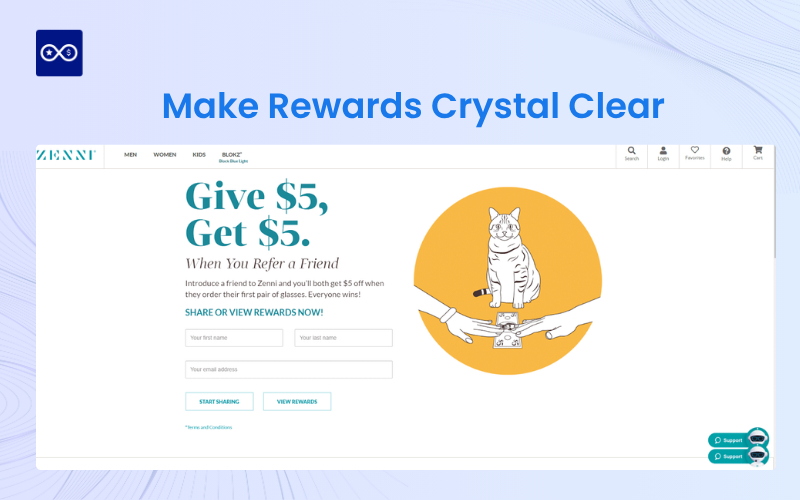
3. Stay On-Brand with Visuals: Use engaging photos, illustrations, or subtle animations that reflect your brand’s personality. A visually appealing landing page gives a great first impression and makes your referral program more memorable.
4. Perfect the Mobile Experience: Most sharing happens on mobile, so your program needs to look and work flawlessly on smaller screens. Keep buttons “thumb-friendly,” make sure forms are short, and test every step on both iOS and Android devices.
Make sharing effortless
The easier you make it to share, the faster your referral program will grow.
- Offer Multiple Sharing Options: Let customers share however they like via email, SMS, or social channels like WhatsApp, Facebook, or X (Twitter). The more flexible your sharing options, the more likely users will spread the word.
- Enable One-Click Sharing: This is the gold standard. Give users a single tap to copy their referral link or share directly. Fewer steps = fewer drop-offs.
- Pre-Written Messages (with a Personal Touch): Provide a default sharing message that sounds natural and friendly — something a friend would actually send. But always give users the freedom to edit it, so they can add their own tone and personality.
- Use Deep Linking: Deep links take referred friends directly to the right spot like your signup page or product offer, instead of making them navigate manually. This small detail can dramatically boost conversion rates.
Add a personal touch
Personalization helps build trust and increases the chances that a referred friend will convert.
- Personalized Landing Pages: Show the referrer’s name, photo, or short message on the referral landing page. It makes the invitation feel real and personal. Airbnb, for example, boosted bookings by 25% simply by adding these small touches.
- Warm, Personal Welcomes: Instead of a generic “Join Now,” greet referred users with messages like, “Sarah thought you’d love this.” It creates instant familiarity and trust.
- Tailored Rewards and Messaging: Use what you know about your customers, like their past purchases or preferences, to make your referral messages more relevant and rewarding.
- Custom Referral Codes: Allow users to create their own referral codes (like “SARAH20”) rather than random strings. It’s easier to remember, share, and track.
Make rewards easy and instant
A strong referral program doesn’t just reward users it celebrates them.
- Show Real-Time Progress: Keep users updated instantly when someone signs up or when they’ve earned a reward. A clear dashboard or progress tracker builds excitement and encourages more sharing.
- Smooth Reward Redemption: Don’t make users hunt for their perks. If the reward is a discount, include a link that takes them straight to checkout with the code already applied.
- Automate Rewards: Use digital, automated rewards wherever possible. They’re fast, error-free, and give customers the instant gratification that keeps them engaged and motivated.
Referral program best practices for promotion and timing
Even the best-designed referral program won’t perform well if people don’t know it exists. To truly maximize participation and conversions, you need to actively promote your program and time your invitations strategically. The goal is to get your customers excited to share — right when they’re feeling happiest about your brand.
Let’s explore how to make your referral program impossible to miss and perfectly timed for success.
Make your program highly visible
Visibility drives participation. The more often customers see your referral program, the more likely they are to join and share it.
1. Consistency Is Key: Don’t just launch your program once and leave it. Keep it visible through consistent, multi-channel promotion. Regular reminders help maintain awareness and encourage more shares over time.
2. Be Everywhere Your Customers Are: Integrate your referral program naturally into every touchpoint customers interact with:
- On Your Website: Add a link in the footer, account dashboard, or main navigation. Pop-ups or banners on thank-you pages can also capture attention right after purchase.
- In Emails: Include referral CTAs in order confirmations, newsletters, and post-purchase follow-ups. Transactional emails like “Your order has shipped!” have some of the highest open rates, making them perfect for promotion.
- On Social Media: Share your referral program in posts, Stories, and profile bios. Create engaging visuals or short videos that remind your followers how easy it is to share and earn rewards.
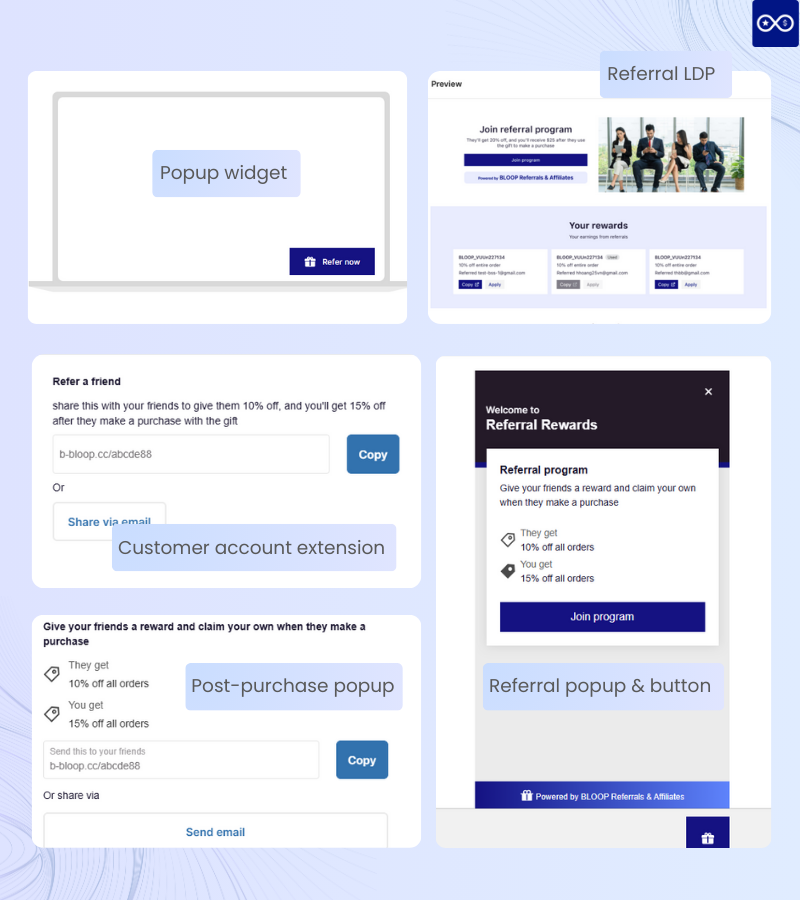
Time your ask perfectly
Timing can make all the difference. The best time to ask for a referral is when your customer is at their happiest, having just experienced your product and felt satisfied.
- Ask During “Peak Satisfaction” Moments: Trigger referral invitations after customers receive their order, leave a positive review, or share positive feedback with your support team. Those are the moments when their excitement is highest and they’re most likely to recommend your brand.
- Capitalize on Moments of Delight: Automate gentle reminders right after a successful checkout or product delivery. A short, cheerful message like “Love your order? Share it with a friend and earn rewards!” feels natural and well-timed.
- Follow Up Thoughtfully: If customers don’t respond to your first invite, don’t give up. Send a friendly follow-up email a few days later, keeping the message concise and highlighting what’s in it for them. End with a clear, irresistible call-to-action (CTA).
Build advocacy and engagement
Your best promoters are already in your customer base — you just need to empower them.
- Start with Loyal Customers: Begin your outreach with customers who’ve purchased multiple times, left great reviews, or engaged regularly with your brand. These are your most authentic advocates and they’ll naturally refer others.
- Show Gratitude: Always thank customers for successful referrals. A simple thank-you message, paired with reward confirmation, not only closes the loop but also encourages them to keep sharing. A little appreciation goes a long way.
- Collaborate with Influencers and Micro-Influencers: Invite influencers to join your referral program and share it with their communities. Even micro-influencers can create powerful ripple effects by introducing your products to smaller but highly engaged audiences.
- Use Time-Sensitive or Exclusive Offers: Limited-time bonuses, such as “Earn double rewards this weekend!” to add urgency and excitement. Temporary boosts like these can quickly increase participation and drive bursts of new customer acquisition.
>> See more: How To Promote a Referral Program For Your Shopify Stores? (15+ Free & Paid Tactics That Work)
Referral program best practices for tracking, optimization, and tools
Use referral software built for Shopify
To scale your referral marketing effectively, you’ll need the right tools. Referral apps designed for Shopify can automate tracking, sharing, and reward distribution, saving time while ensuring accuracy. Among these tools, Bloop Referrals & Affiliates stands out for one reason: it makes the entire referral setup process unbelievably simple.
Here’s what makes it different:
- Super Simple, One-Screen Setup: With Bloop, all setup steps happen within one unified page. Each stage from reward configuration to design and sharing options is organized into clearly labeled tabs you can move through in order. Everything you need to build your campaign is right there, in one place.
- Guided, Flow-Based Setup (Perfect for Beginners): Instead of dropping you into a blank setup screen, Bloop guides you step-by-step with a logical flow and template-based guidance. Each section includes pre-filled examples and tips, helping even first-time users understand what to do. In fact, you can successfully launch your first campaign in under 30 minutes, no coding, no confusion.
- Seamless Shopify Integration: Because it’s built for Shopify, Bloop connects effortlessly with your store’s customer data, checkout process, and email system. This ensures your referral rewards, tracking, and follow-ups are 100% automated and reliable.
>> Start free trial or Book a demo to explore our powerful app now!
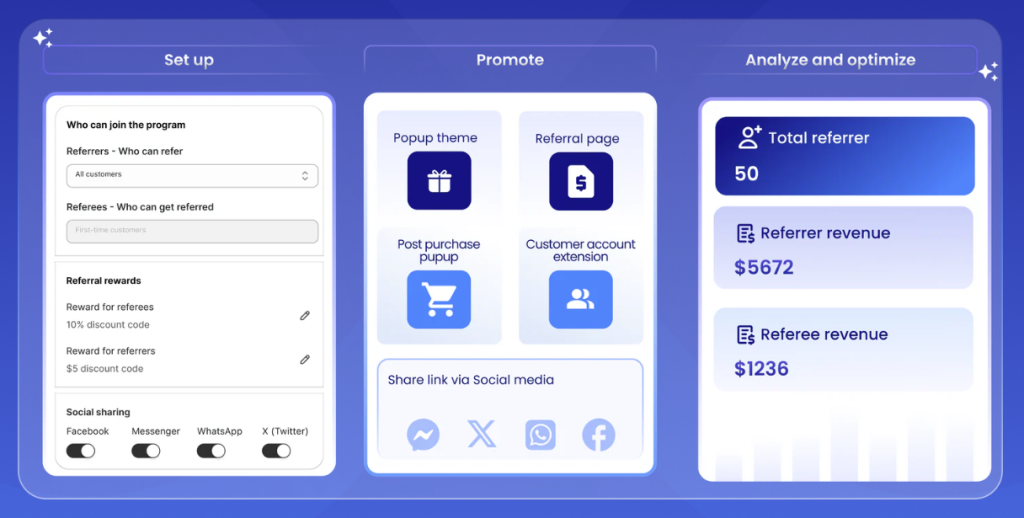
Track Key Referral Metrics
Monitor essential KPIs such as participation rate (percentage of customers who refer), share rate, and conversion rate from referrals. Calculate referral-driven revenue, overall ROI, and compare CPA against customer lifetime value (CLV) to gauge long-term impact.
Continuously optimize
Run A/B tests on messaging, reward types, and landing page designs to refine your approach. Analyze data to spotlight high-performing advocates and adjust incentives or timing based on insights, ensuring your program evolves with your business.
10+ Inspiring referral program examples for E-commerce
Here are 10 brand examples that showcase referral program best practices, tailored for eCommerce, D2C, and subscription models. These illustrate real strategies that drive results.
1. Casper (Double-sided incentive with mixed rewards)
Casper, the mattress brand that made “bed-in-a-box” famous, knows how to turn happy sleepers into loyal advocates.
- Practice Illustrated: Offering mutual benefits through discounts for both parties to encourage participation.
- Example: Advocates receive 30% off their next purchase when a friend buys using their link, while the friend gets 30% off their first order. This win-win setup has helped Casper build trust and expand its customer base efficiently.
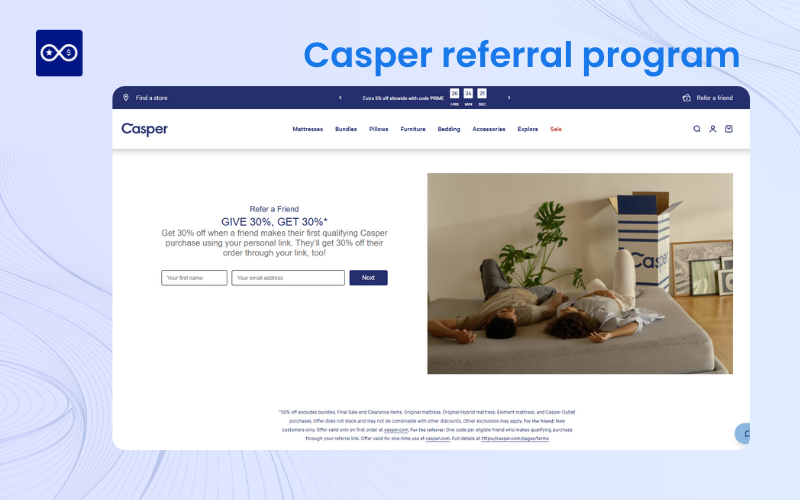
2. Vera Bradley (minimum purchase requirement for profitability)
Vera Bradley shows that referral programs can be generous and sustainable at the same time.
- Practice Illustrated: Requiring a minimum spend to qualify for rewards, ensuring profitability on referrals.
- Example: Both the advocate and referred friend get 20% off, but only if the friend’s first order is $100 or more. This threshold keeps the program sustainable for the brand.
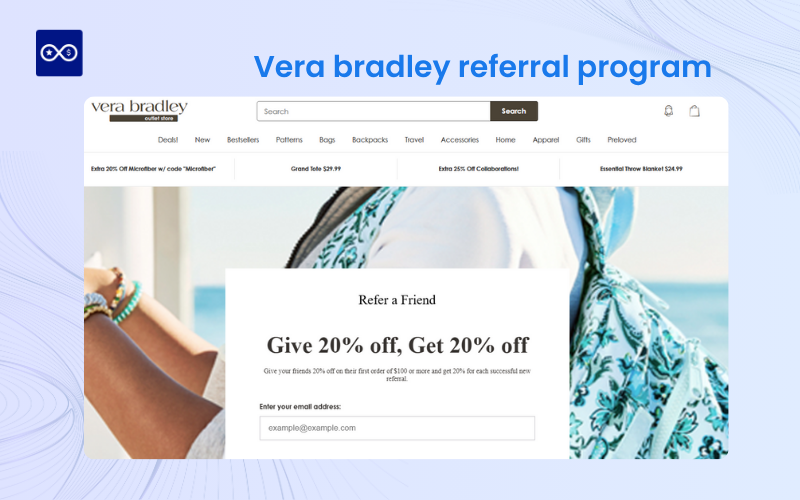
3. Rothy’s (tiered/milestone rewards for loyalty)
Rothy’s, loved for its eco-friendly shoes, keeps things simple yet powerful with its referral approach.
- Practice Illustrated: Simple give-get structures that reward ongoing advocacy.
- Example: Referrers earn $20 off for each successful referral, and friends get $20 off their first purchase of $50+. This encourages repeat sharing among eco-conscious customers.
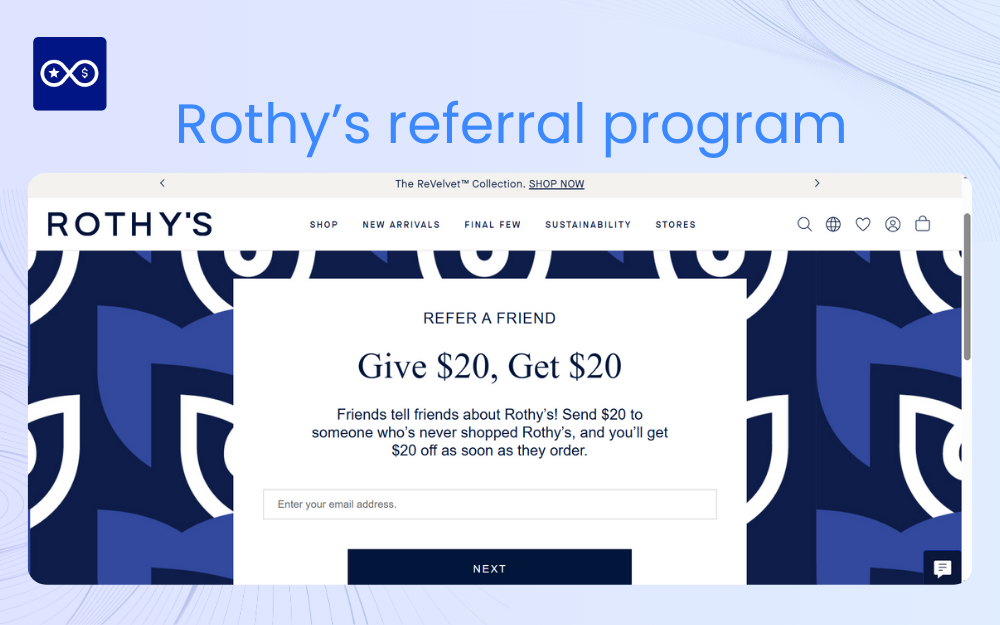
4. AllPlants (value-aligned)
AllPlants shows how aligning rewards with your mission can make a referral program more meaningful.
- Practice Illustrated: Tying incentives to brand values for authentic promotion.
- Example: Referrers and friends each get £20 off, with the program emphasizing sustainability to motivate shares. Past campaigns have included eco-friendly perks like tree-planting for referrals, boosting engagement.
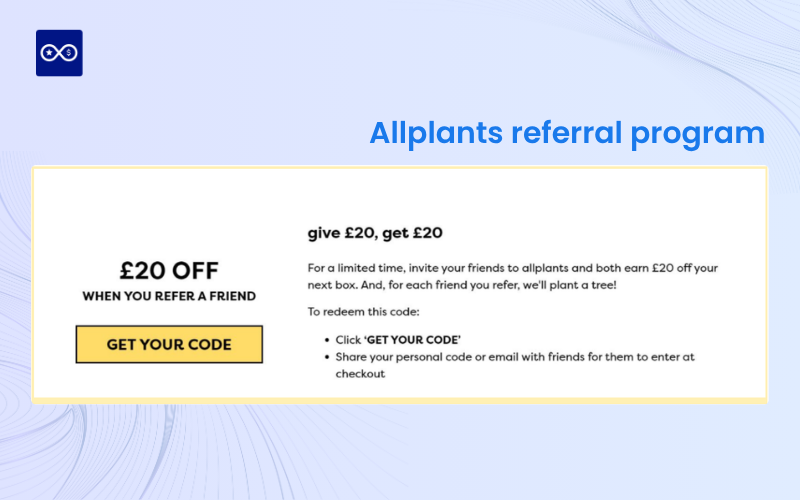
5. Wild Skincare (clear and simple incentive communication)
Wild, the natural deodorant brand, keeps things refreshingly simple, just like its products.
- Practice Illustrated: Using catchy, transparent slogans to convey rewards quickly.
- Example: The program offers friends 50% off their first order, with referrers earning rewards like free cases or discounts. Simple communication ensures quick decisions to participate.
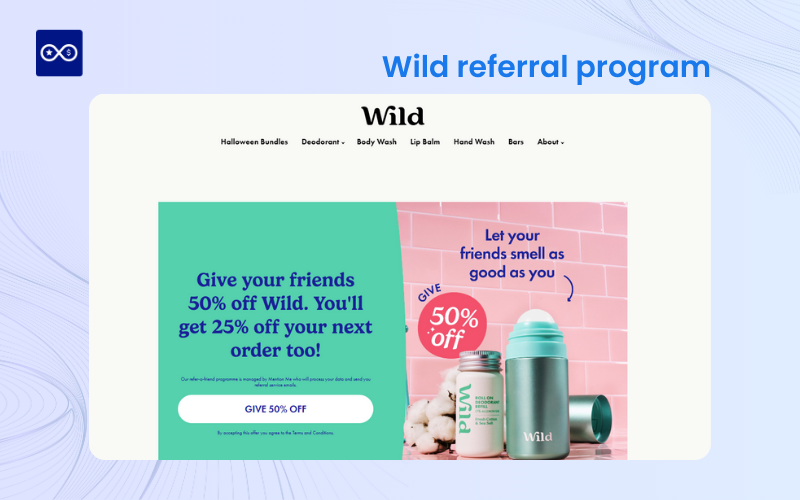
6. Doordash (prominent visibility and easy sharing)
Doordash, a food delivery platform, makes referrals frictionless.
- Practice Illustrated: Highlighting rewards clearly and enabling instant sharing.
- Example: Users earn credits for successful referrals, with easy options to share via text or email. This low-effort approach drives high participation in a fast-paced market.
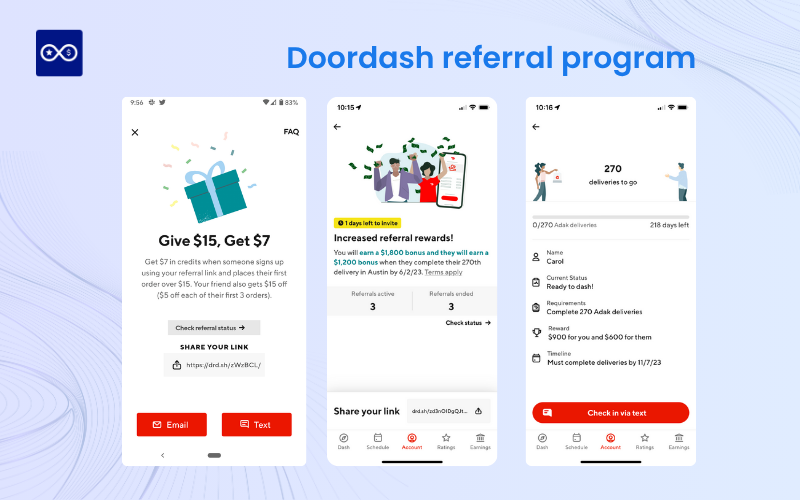
7. Zalora (influencer/affiliate hybrid promotion)
Zalora, a fashion e-retailer, blends referrals with influencer partnerships.
- Practice Illustrated: Leveraging influencers for amplified reach and commissions.
- Example: Influencers share promo codes for 20-25% discounts to followers, earning commissions per sale. This hybrid model boosts visibility and sales through trusted networks.
8. ColourPop (visually engaging and inclusive design)
ColourPop, a cosmetics brand, focuses on appealing visuals.
- Practice Illustrated: Designing eye-catching referral pages that reflect brand values.
- Example: Friends get 20% off their first order, and referrers earn $5-10 credits. The page features diverse imagery, enhancing inclusivity and brand impression.
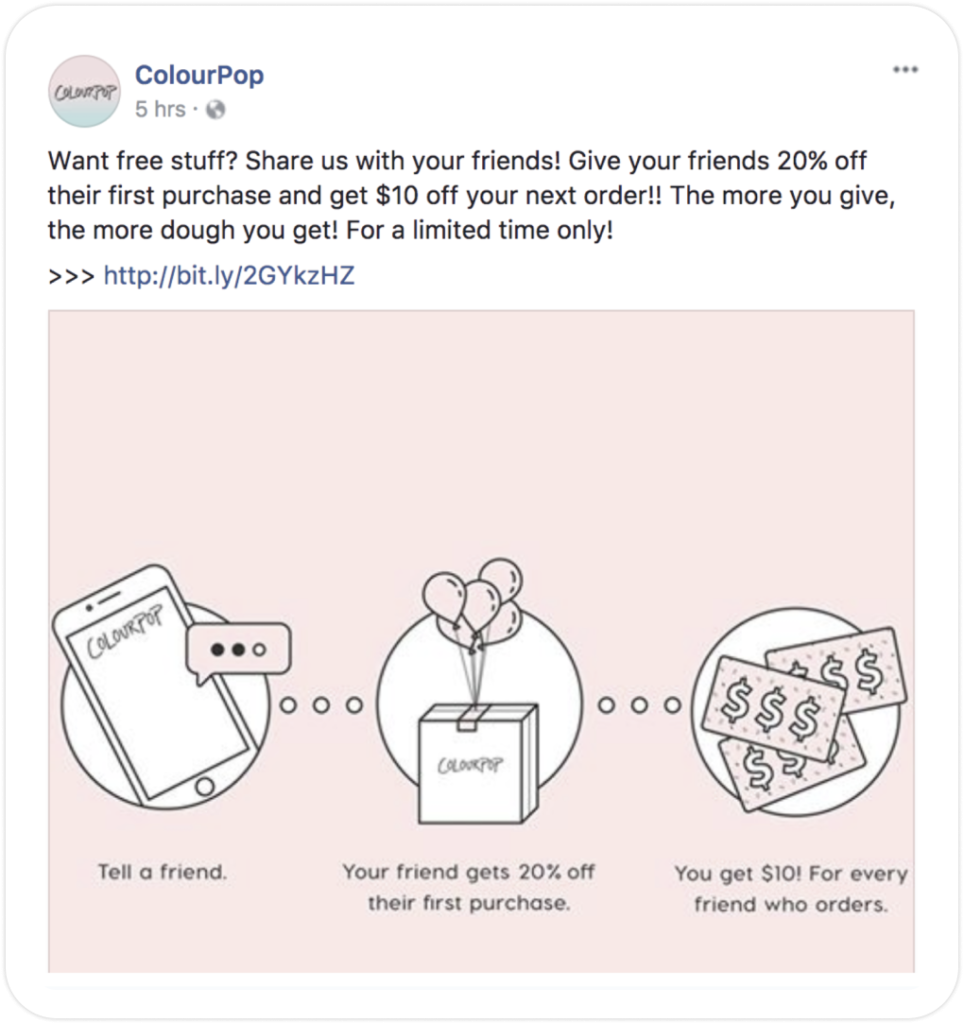
9. Outdoorsy (Rewards Tied to Future Service Use)
Outdoorsy, an RV rental marketplace, ties rewards to platform loyalty.
- Practice Illustrated: Providing credits redeemable for future bookings to encourage retention.
- Example: Referrers earn $75-100 in credits when a friend books a qualifying trip, usable only on the platform. This keeps users engaged long-term.
10. Harry’s (Simplicity and Frictionless Sharing)
Harry’s, a D2C grooming brand, mastered pre-launch referrals.
- Practice Illustrated: Minimizing steps with simple interfaces for rapid adoption.
- Example: Their campaign used tiered rewards (e.g., free products for 5-50 referrals), generating 100,000 emails in a week through easy sharing.
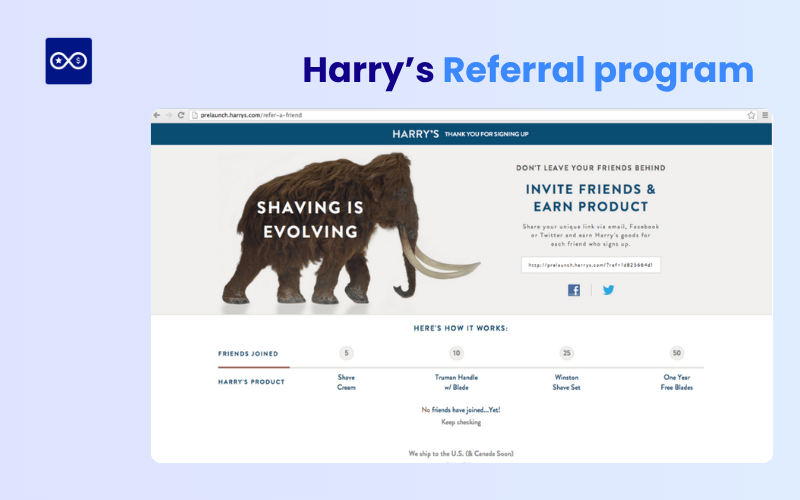
Free Shopify referral program best practice template
Jumpstart your referral journey with our free, ready-to-use setup guide built entirely around Bloop’s workflow. This Google Sheet template walks you through every stage of creating a complete referral program from defining goals and setting up rewards to designing campaign messages and tracking performance. It’s a hands-on way to plan, test, and structure your program before launching it live in Bloop.
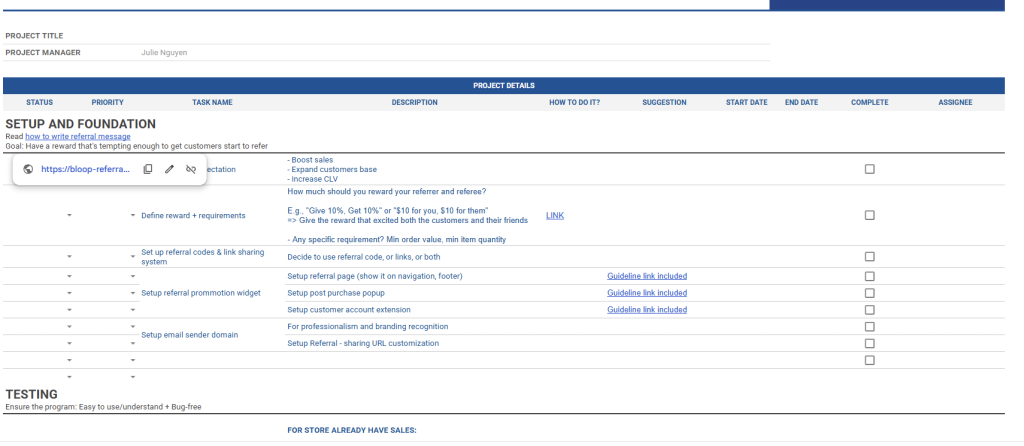
In summary, the top referral program best practices revolve around starting with a great product, offering smart incentives, ensuring clear UX, and committing to ongoing optimization. These strategies lead to higher retention, reduced CAC, and scalable brand growth for Shopify merchants. Don’t wait, start your Shopify referral program today with our free template and watch your customers become your most powerful growth engine.